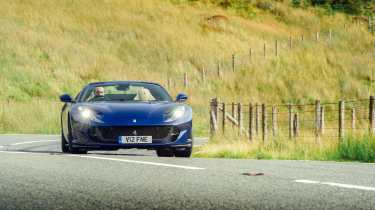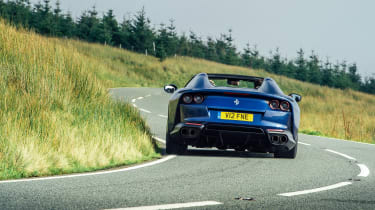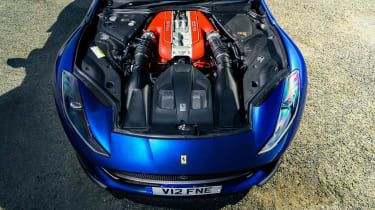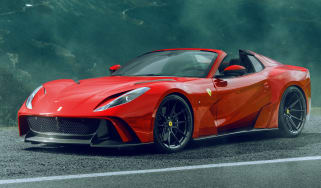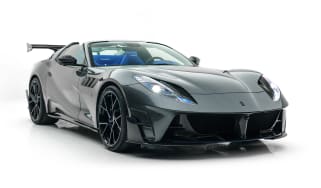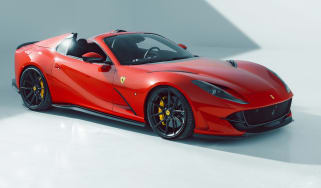Ferrari 812 GTS (2020 – 2024) review – the ultimate open-top V12 thrill
A wonderful combination of near-hypercar pace and open air driving, the 812 GTS was a return to the genre for Ferrari
Although Ferrari has a fine tradition of chopping the roof off its V12-powered coupes, in recent years it has reserved that for limited-run ‘specials' like the 599 SA Aperta. That changed with the arrival of this, the 812 GTS, Ferrari's first series-production V12 convertible since the 365 GTS/4 Daytona Spider. The bloodline continues too, with the 12 Cilindri Spider taking the place of the 812 GTS, launching unlike its predecessor, alongside the coupe on which it's based.
What was at the time Ferrari’s flagship berlinetta, the 812 existed almost in a class of its own, combining all the firepower of a contemporary supercar – or maybe even hypercar – within a traditional, front-engined package. The 812 Superfast was every bit as fast as its name suggests and chopping the top removed any barrier between the driver and the V12's intoxicating vocals.
Engine, transmission and 0-62 time
The Tipo F140GA naturally aspirated V12 was yet another iteration of a masterpiece, producing 789bhp and 530lb ft of torque. It pulls effectively from just above idle and doesn’t then stop until nearly 9000rpm (the limiter calls time at 8900rpm). The final third of the rev band possessed all the manic energy of a 1-litre superbike. That engine was connected to a seven-speed dual-clutch gearbox and deployed with a vast armada of electronic systems. 0-60mph took less than three seconds and the top speed matched the coupe at 211mph+.
More reviews
For all the many good things about the 812 GTS, there’s one aspect of its personality that is the biggest, laziest cliche going: it is a car dominated by its engine. It’s probably fair to say that the time for engines such as this one is distinctly numbered, which makes it something to savour all the more while we still can.
While the 812’s electronics deny the prospect of pulling away in top gear like the party trick of a classic Ferrari V12, there’s no denying if so allowed, this V12 would happily oblige; it’s superbly tractable, and is already pulling hard by 2000rpm even in a high gear. By 3000rpm it’s really motoring, by 4,000rpm you’re already faster than just about anything else on the road, and then, at 5000rpm, it really wakes up.
The engine’s note begins to harden, and the rate of acceleration picks up again. Between 6000-8900rpm is where the real power band is, and frankly it’s very hard to find the space and lack of surrounding humanity to indulge in the warp speed acceleration the engine then provides. Some may therefore question the point, but it’s such a thrill to occasionally take the engine there, and of course, just knowing you could will be enough for many.
Technical highlights
Ferrari stayed loyal to the metal retractable hard top in an era when some had started a return to the lighter, more easily packaged soft top. Indeed, Ferrari itself would return to a fabric top with the Roma Spider, its first since the F430 Spider.
The 812 GTS's top pops in 14 seconds, and at speeds of up to 28mph, meaning there’s a chance you might escape getting your expensive leather interior wet should you be able to drive slowly enough for a short period. There’s also a small window behind the seats that can be electrically operated independently, acting as a wind deflector with the roof down, but also providing some of the sensations of open-air motoring even when the roof is in place.
The penalty for the above was a requirement to strengthen the 812’s body, which resulted in a 120kg increase (the GTS weighs 1645kg ‘dry’) in the overall weight when including the roof and its accompanying mechanism. Ferrari also worked to maintain the aerodynamic properties of the 812, while attempting to manage airflow and hence occupant comfort in a roofless car that can exceed 200mph.
Ride and handling
The 812 GTS always felt like a very big car – disarmingly so to begin with – but it’s an easy one to place once you’ve built some confidence in its reactions, and learnt to exploit the precision its chassis affords you. The steering is light and very fast in its ratio, which again, does take some familiarisation like all modern Ferraris, but you do get into a groove with the GTS.
While Ferrari only admitted to recalibrating the suspension to suit the additional weight and change in its centre of gravity, the GTS does feel a little softer riding than the Superfast, but even so, the ‘bumpy road’ switch on the wheel is worth pressing to smooth it out even further.
Using the manettino it’s possible to make the GTS increasingly angry, while simultaneously stripping away layers of protective electronics. It’s a car that will lose traction extremely easily given even mild provocation, and while it’s possible to hold a slide it takes very accurate throttle and steering inputs to hold and then gather it all back up. Most of the time though, the GTS just glides along, with so much in reserve.
Ferrari 812 GTS: Values, rivals and successors
The 812 GTS cost from £293,150 when new and always had the potential to sell for an awful lot more once options and personalisation was applied. The GTS was only produced for a few short years, arriving three years after the coupe. There aren't, therefore, as many examples out there. Prices today, as when new, start from around £290,000 and go all the way up to over £400,000. So at worst, depreciation can be counted in accordance with inflation.
In 2025 the 812 GTS's place in Ferrari's lineup is occupied by the 12 Cilindri Spider. A successor though it is, it's a different type of car – less intense, less raw, the V12 a more distant cog in its constitution. In a way, then, the 812 GTS was never succeeded. For some, it certainly hasn't been beaten by the 12 Cilindri Spider.
By the numbers – both in terms of price and power – the 812 GTS could count the Aston Martin DBS Volante and the Lamborghini Aventador S Roadster among its closest rivals. The Aston less precise with a V12 dulled by turbocharging and the Lambo a full-on supercar personality (with supercar flaws), the 812 was a deft and compelling combination; a subtle open-air GT with the soul of a hypercar.
Ferrari 812 GTS specs
| Engine | V12, 6496cc |
|---|---|
| Transmission | Seven-speed dual-clutch, rear-wheel drive |
| Power | 789bhp @ 8500rpm |
| Torque | 529lb @ 7000rpm |
| Weight | 1750kg (450bhp/ton) |
| 0-62mph | 3sec (claimed) |
| Top speed | 211mph |
| Price new | £293k |
| Price now | From £293k |

